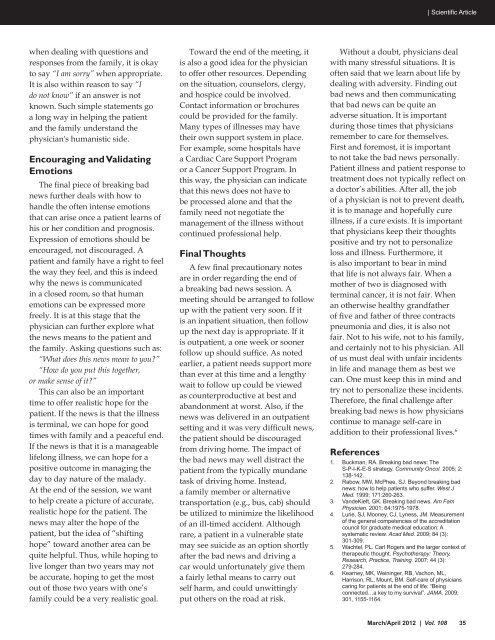March/April - West Virginia State Medical Association
March/April - West Virginia State Medical Association
March/April - West Virginia State Medical Association
- No tags were found...
Create successful ePaper yourself
Turn your PDF publications into a flip-book with our unique Google optimized e-Paper software.
| Scientific Articlewhen dealing with questions andresponses from the family, it is okayto say “I am sorry” when appropriate.It is also within reason to say “Ido not know” if an answer is notknown. Such simple statements goa long way in helping the patientand the family understand thephysician's humanistic side.Encouraging and ValidatingEmotionsThe final piece of breaking badnews further deals with how tohandle the often intense emotionsthat can arise once a patient learns ofhis or her condition and prognosis.Expression of emotions should beencouraged, not discouraged. Apatient and family have a right to feelthe way they feel, and this is indeedwhy the news is communicatedin a closed room, so that humanemotions can be expressed morefreely. It is at this stage that thephysician can further explore whatthe news means to the patient andthe family. Asking questions such as:“What does this news mean to you?”“How do you put this together,or make sense of it?”This can also be an importanttime to offer realistic hope for thepatient. If the news is that the illnessis terminal, we can hope for goodtimes with family and a peaceful end.If the news is that it is a manageablelifelong illness, we can hope for apositive outcome in managing theday to day nature of the malady.At the end of the session, we wantto help create a picture of accurate,realistic hope for the patient. Thenews may alter the hope of thepatient, but the idea of “shiftinghope” toward another area can bequite helpful. Thus, while hoping tolive longer than two years may notbe accurate, hoping to get the mostout of those two years with one’sfamily could be a very realistic goal.Toward the end of the meeting, itis also a good idea for the physicianto offer other resources. Dependingon the situation, counselors, clergy,and hospice could be involved.Contact information or brochurescould be provided for the family.Many types of illnesses may havetheir own support system in place.For example, some hospitals havea Cardiac Care Support Programor a Cancer Support Program. Inthis way, the physician can indicatethat this news does not have tobe processed alone and that thefamily need not negotiate themanagement of the illness withoutcontinued professional help.Final ThoughtsA few final precautionary notesare in order regarding the end ofa breaking bad news session. Ameeting should be arranged to followup with the patient very soon. If itis an inpatient situation, then followup the next day is appropriate. If itis outpatient, a one week or soonerfollow up should suffice. As notedearlier, a patient needs support morethan ever at this time and a lengthywait to follow up could be viewedas counterproductive at best andabandonment at worst. Also, if thenews was delivered in an outpatientsetting and it was very difficult news,the patient should be discouragedfrom driving home. The impact ofthe bad news may well distract thepatient from the typically mundanetask of driving home. Instead,a family member or alternativetransportation (e.g., bus, cab) shouldbe utilized to minimize the likelihoodof an ill-timed accident. Althoughrare, a patient in a vulnerable statemay see suicide as an option shortlyafter the bad news and driving acar would unfortunately give thema fairly lethal means to carry outself harm, and could unwittinglyput others on the road at risk.Without a doubt, physicians dealwith many stressful situations. It isoften said that we learn about life bydealing with adversity. Finding outbad news and then communicatingthat bad news can be quite anadverse situation. It is importantduring those times that physiciansremember to care for themselves.First and foremost, it is importantto not take the bad news personally.Patient illness and patient response totreatment does not typically reflect ona doctor’s abilities. After all, the jobof a physician is not to prevent death,it is to manage and hopefully cureillness, if a cure exists. It is importantthat physicians keep their thoughtspositive and try not to personalizeloss and illness. Furthermore, itis also important to bear in mindthat life is not always fair. When amother of two is diagnosed withterminal cancer, it is not fair. Whenan otherwise healthy grandfatherof five and father of three contractspneumonia and dies, it is also notfair. Not to his wife, not to his family,and certainly not to his physician. Allof us must deal with unfair incidentsin life and manage them as best wecan. One must keep this in mind andtry not to personalize these incidents.Therefore, the final challenge afterbreaking bad news is how physicianscontinue to manage self-care inaddition to their professional lives. 6References1. Buckman, RA. Breaking bad news: TheS-P-I-K-E-S strategy. Community Oncol. 2005; 2:138-142.2. Rabow, MW, McPhee, SJ. Beyond breaking badnews: how to help patients who suffer. <strong>West</strong> JMed. 1999; 171:260-263.3. VandeKieft, GK. Breaking bad news. Am FamPhysician. 2001; 64:1975-1978.4. Lurie, SJ, Mooney, CJ, Lyness, JM. Measurementof the general competencies of the accreditationcouncil for graduate medical education: Asystematic review. Acad Med. 2009; 84 (3):301-309.5. Wachtel, PL. Carl Rogers and the larger context oftherapeutic thought. Psychotherapy: Theory,Research, Practice, Training. 2007; 44 (3):279-284.6. Kearney, MK, Weininger, RB, Vachon, ML,Harrison, RL, Mount, BM. Self-care of physicianscaring for patients at the end of life: “Beingconnected…a key to my survival”. JAMA. 2009;301, 1155-1164.<strong>March</strong>/<strong>April</strong> 2012 | Vol. 108 35















